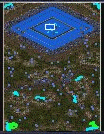CBM2ASC
CBM2ASC converts a Commodore ASCII file to standard ASCII. It runs on
MS-DOS or a DOS box under Windows. I have placed it in the public domain.
The Commodore 64’s “ASCII” character set is substantially different
from the ASCII character set used by most machines—so different that if you
try viewing, on a PC, an unconverted Commodore 64 text file, you will
mostly just see garbage. CBM2ASC makes the text legible again. CBM2ASC
is also fine-tuned to the conversion of two specific types of Commodore
text files, selected by passing an option
on the CBM2ASC command line. These specific types of files are Commodore
BASIC programs, and documents written with the SpeedScript word processor.
CBM2ASC cannot convert many of the specialized Commodore ASCII codes,
notably graphics characters which have no equivalent in the PC’s ASCII
character set. But it does convert the standard characters (the symbols
typically found on typewriter keyboards). The “Commodore BASIC”
option converts just about everything except graphics characters within
BASIC strings, and the “SpeedScript” option converts an entire
SpeedScript file except for escape codes, which affect text formatting, not
content.
The usual procedure is to first copy the raw floppy disk image from the
Commodore 64 disk drive to the PC using an X1541 cable and associated software (at least
one enterprise appears to
sell these cables, but I assembled my own cable so I have not interacted
with them). Once the raw disk image is sitting on the PC, the next step is
to use a utility like D64T641 to break the disk image up into individual binary
files sitting in a DOS directory. The binary file names typically end in
.PRG or .SEQ, and they correspond to individual
files on the original Commodore 64 disk. Finally, CBM2ASC comes in, converting a
desired binary file from Commodore ASCII to standard ASCII.
Download CBM2ASC now
[22 kB].
The ZIP file contains the CBM2ASC executable (version 1.1, dated 1999 Jan. 28), and a text
file that explains the program and its usage in more detail.
1Unfortunately, this utility no longer seems to be available on
the Internet. CTools04 appears to provide the
same functionality, but I have not used it. A variety of Commodore 64 file
utilities are available at http://www.fairlight.to/tools/pc.html.
 Now available—the classic ‘M’ logo, for your
Windows desktop!
Tired of the bland graphics that remind you everyday of your computer’s
fealty to Microsoft Corporation? Replace them with graphics to remind
you everyday of your new fealty to Meyer Gigacorporation! mlogo.zip [287 kB]
includes a textured high-resolution bitmap for use as a desktop background,
and startup and shutdown screens for Windows 95/98/Me. The image at left
shows the animation of the startup screen once it is installed.
Installation instructions are in the README file within mlogo.zip.
Unfortunately, Microsoft changed the specifications, so that these startup and shutdown screens will not work under Windows 2000 or XP. You can probably guess
as to why Microsoft did this.
Now available—the classic ‘M’ logo, for your
Windows desktop!
Tired of the bland graphics that remind you everyday of your computer’s
fealty to Microsoft Corporation? Replace them with graphics to remind
you everyday of your new fealty to Meyer Gigacorporation! mlogo.zip [287 kB]
includes a textured high-resolution bitmap for use as a desktop background,
and startup and shutdown screens for Windows 95/98/Me. The image at left
shows the animation of the startup screen once it is installed.
Installation instructions are in the README file within mlogo.zip.
Unfortunately, Microsoft changed the specifications, so that these startup and shutdown screens will not work under Windows 2000 or XP. You can probably guess
as to why Microsoft did this.

